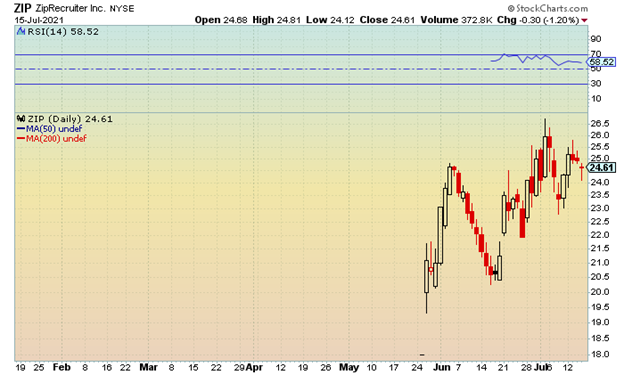ZipRecruiter (ZIP) recently became a publicly-traded company, following its direct listing on the New York Stock Exchange in late May. The debut was a little different from an initial public offering because the company didn’t need the funding as shares came from stockholders.
The company offered nearly 87 million shares for resale and didn’t receive any proceeds from the direct listing, as it is currently cash-flow positive. The company became profitable in 2020, 10 years after being founded, after reporting $86 million in income versus a loss of $6.3 million in 2019. Revenue last year came in at $418 million in 2020.
ZipRecruiter is a leading job recruiting site and is well-positioned to benefit from the recent increase in online recruitment spending. Wall Street expects the company to disrupt the traditional recruiting market by streamlining the hiring process for employers and personalizing the online search experience for job applicants.
One of the company’s key advantages over its competitors is its artificial intelligence-powered matching technology, which drives better outcomes for employers and job applicants. Nearly three million businesses have used ZIP to find an employee, with 110 million job applicants using the service.
The technology has reduced the average amount of time employers need to find staff to just over two weeks, down from the 49-day average reported over the past four years. Even more impressive is that the company is still in its early days of innovation, with much greater improvement possible.
With the economy recovering, the job market should continue to improve over the next few months, with more and more people getting vaccinated and schools reopening. Current estimates state that 16 million Americans are unemployed, with nearly 10 million job openings and most state unemployment benefits ending in September.
Analysts predict ZIP will report a loss between $0.17 and $0.27 per share on revenue of $160 million for the current quarter. For the full year 2021, forecasts are sandwiched between a profit of $0.07 and a loss of $0.08, with revenue of $595 million, on average. For 2022, these numbers improve to a profit between $0.28 and $0.54 a share, on revenue of $705 million.
There are currently five brokerage firms that have initiated coverage of the stock, with two outperform ratings, two strong buys, and one neutral rating. The price targets range between $24-$36, with the former representing the neutral rating.
It is a little early to get a longer-term technical analysis of the stock with current support near $23.50–$23 if $24 fails to hold. Resistance is at $25.50–$26.
Options are available to trade on ZIP, with the furthest out going into September. More option listings will likely become available once the company has announced a quarter or two’s worth of earnings.
Conservative traders can consider writing covered calls at current levels to establish positions in the low $20’s. With the current high at $26.71 and options trading in $2.50 and $5 increments and pricey premiums, it is a little risky buying out-of-the-money call options as a directional play.







